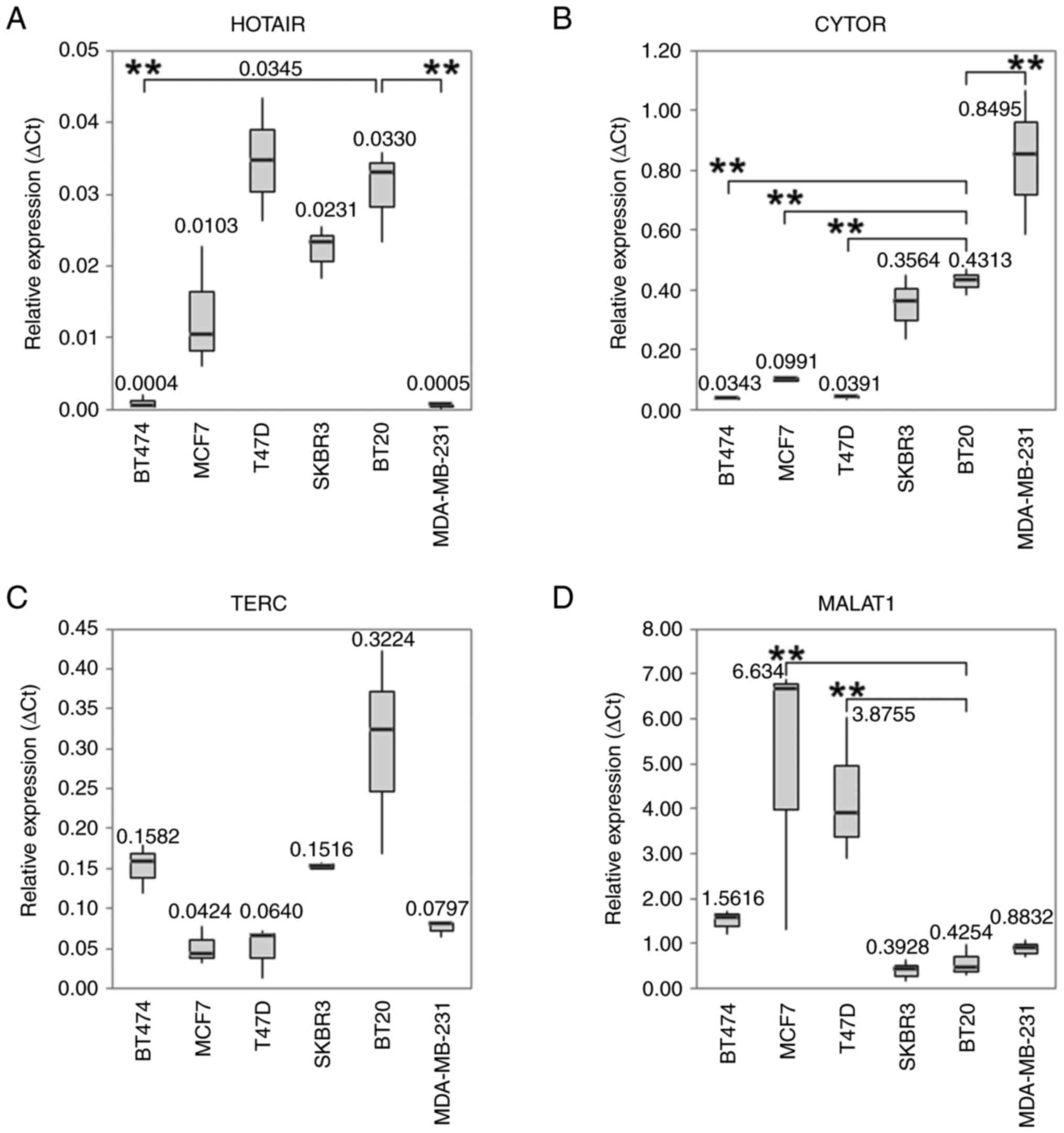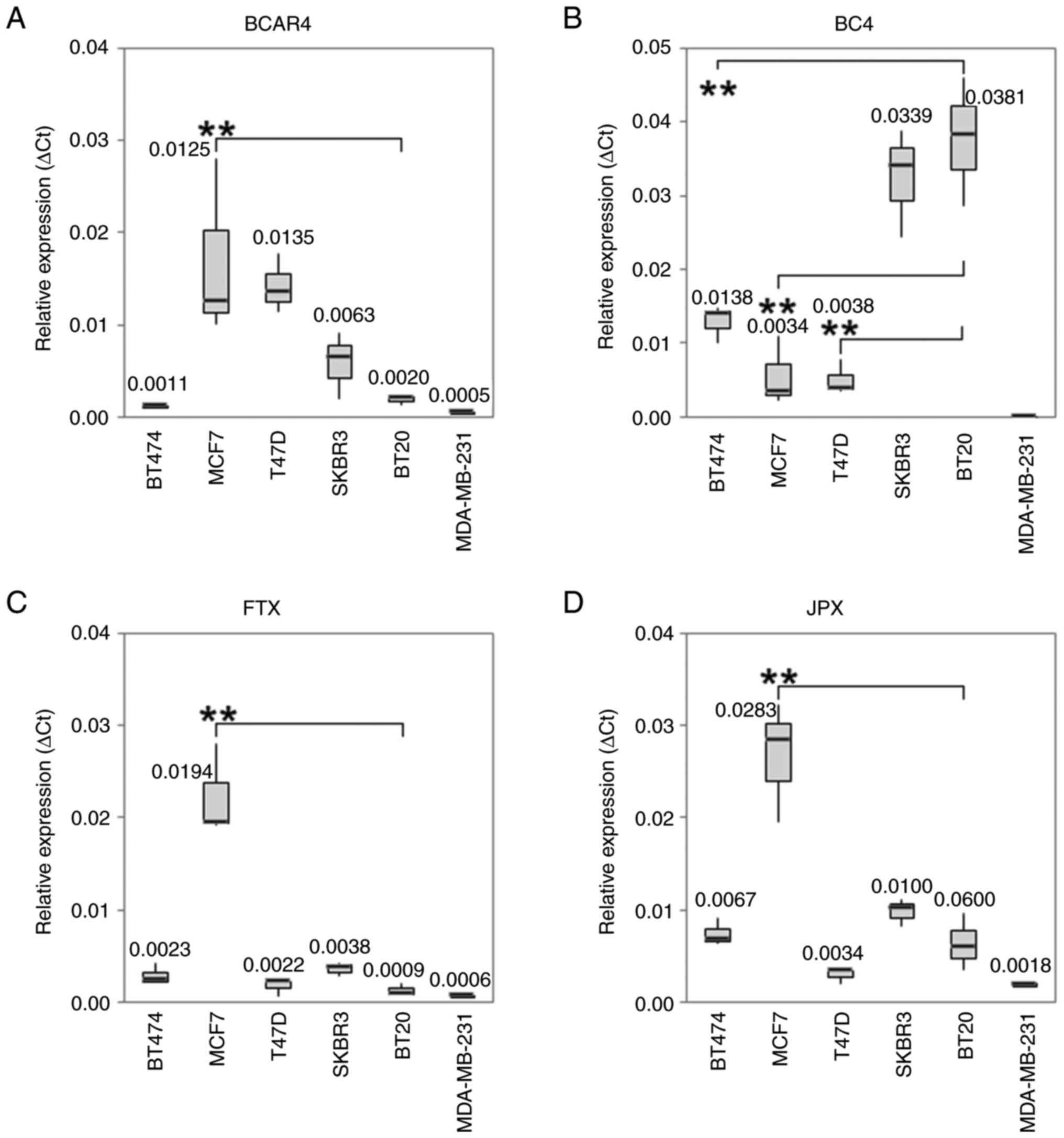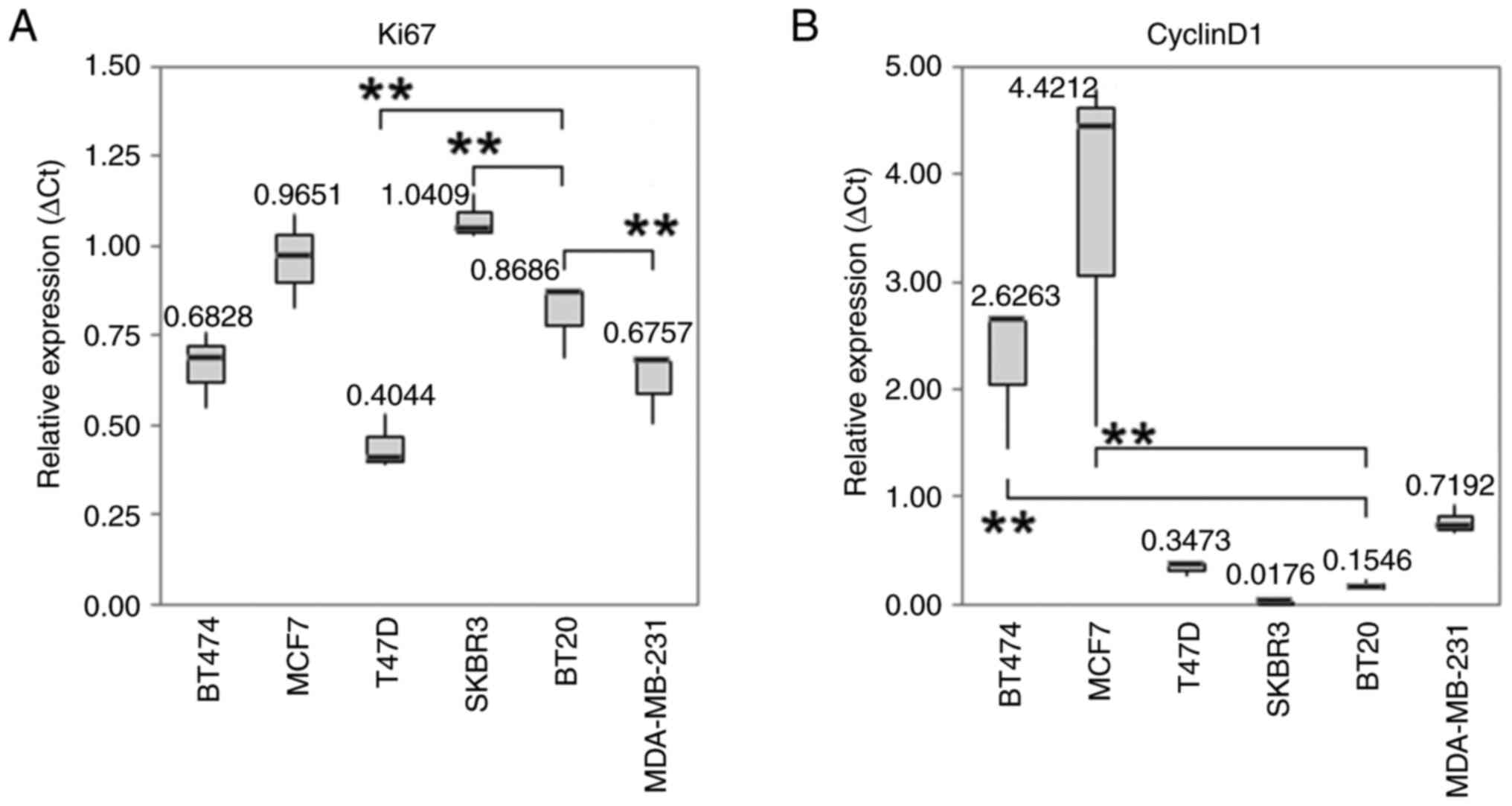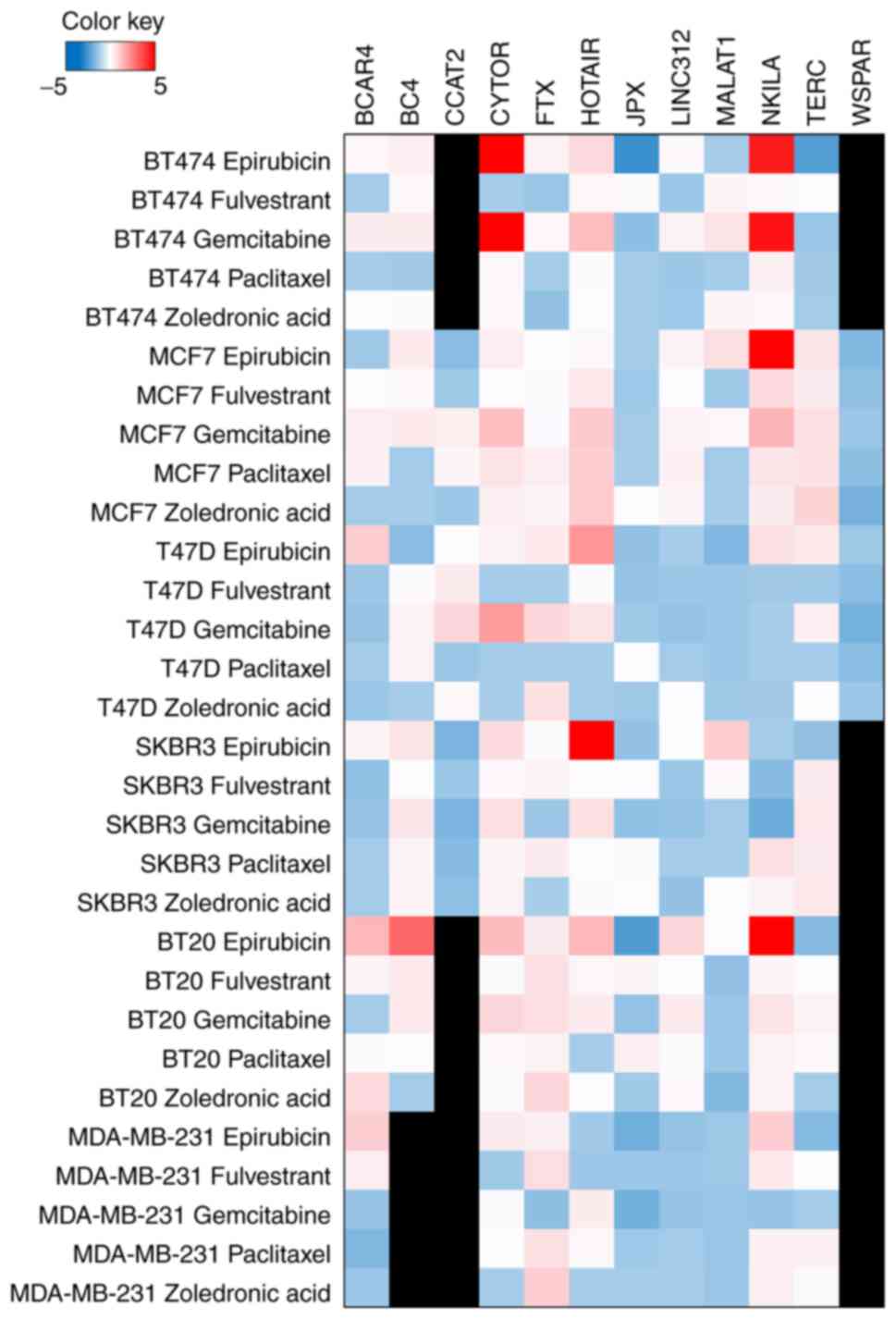|
1
|
Bray F, Ferlay J, Soerjomataram I, Siegel
RL, Torre LA and Jemal A: Global cancer statistics 2018: GLOBOCAN
estimates of incidence and mortality worldwide for 36 cancers in
185 countries. CA Cancer J Clin. 68:394–424. 2018.PubMed/NCBI View Article : Google Scholar
|
|
2
|
Siegel RL, Miller KD, Wagle NS and Jemal
A: Cancer statistics, 2023. CA Cancer J Clin. 73:17–48.
2023.PubMed/NCBI View Article : Google Scholar
|
|
3
|
Prat A, Parker JS, Karginova O, Fan C,
Livasy C, Herschkowitz JI, He X and Perou CM: Phenotypic and
molecular characterization of the claudin-low intrinsic subtype of
breast cancer. Breast Cancer Res. 12(R68)2010.PubMed/NCBI View
Article : Google Scholar
|
|
4
|
Perou CM, Sørlie T, Eisen MB, van de Rijn
M, Jeffrey SS, Rees CA, Pollack JR, Ross DT, Johnsen H, Akslen LA,
et al: Molecular portraits of human breast tumours. Nature.
406:747–752. 2000.PubMed/NCBI View
Article : Google Scholar
|
|
5
|
Sørlie T, Perou CM, Tibshirani R, Aas T,
Geisler S, Johnsen H, Hastie T, Eisen MB, van de Rijn M, Jeffrey
SS, et al: Gene expression patterns of breast carcinomas
distinguish tumor subclasses with clinical implications. Proc Natl
Acad Sci USA. 98:10869–10874. 2001.PubMed/NCBI View Article : Google Scholar
|
|
6
|
Harbeck N and Gnant M: Breast cancer.
Lancet. 389:1134–1150. 2017.PubMed/NCBI View Article : Google Scholar
|
|
7
|
Teshome M and Hunt KK: Neoadjuvant therapy
in the treatment of breast cancer. Surg Oncol Clin N Am.
23:505–523. 2014.PubMed/NCBI View Article : Google Scholar
|
|
8
|
Early Breast Cancer Trialists'
Collaborative Group (EBCTCG). Effects of chemotherapy and hormonal
therapy for early breast cancer on recurrence and 15-year survival:
An overview of the randomised trials. Lancet. 365:1687–1717.
2005.PubMed/NCBI View Article : Google Scholar
|
|
9
|
Rani A, Stebbing J, Giamas G and Murphy J:
Endocrine resistance in hormone receptor positive breast
cancer-from mechanism to therapy. Front Endocrinol (Lausanne).
10(245)2019.PubMed/NCBI View Article : Google Scholar
|
|
10
|
Gilbert LA and Hemann MT: DNA
damage-mediated induction of a chemoresistant niche. Cell.
143:355–366. 2010.PubMed/NCBI View Article : Google Scholar
|
|
11
|
Kellokumpu-Lehtinen P, Tuunanen T, Asola
R, Elomaa L, Heikkinen M, Kokko R, Järvenpää R, Lehtinen I, Maiche
A, Kaleva-Kerola J, et al: Weekly paclitaxel-an effective treatment
for advanced breast cancer. Anticancer Res. 33:2623–2627.
2013.PubMed/NCBI
|
|
12
|
Bergh J, Jonsson PE, Glimelius B and
Nygren P: SBU-group. Swedish Council of Technology Assessment in
Health Care: A systematic overview of chemotherapy effects in
breast cancer. Acta Oncol. 40:253–281. 2001.PubMed/NCBI View Article : Google Scholar
|
|
13
|
Khasraw M, Bell R and Dang C: Epirubicin:
Is it like doxorubicin in breast cancer? A clinical review. Breast.
21:142–149. 2012.PubMed/NCBI View Article : Google Scholar
|
|
14
|
Seidman AD: Gemcitabine as single-agent
therapy in the management of advanced breast cancer. Oncology
(Williston Park). 15 (2 Suppl 3):S11–S14. 2001.PubMed/NCBI
|
|
15
|
Bonadonna G, Gianni L, Santoro A, Bonfante
V, Bidoli P, Casali P, Demicheli R and Valagussa P: Drugs ten years
later: Epirubicin. Ann Oncol. 4:359–369. 1993.PubMed/NCBI View Article : Google Scholar
|
|
16
|
Weaver BA: How Taxol/paclitaxel kills
cancer cells. Mol Biol Cell. 25:2677–2681. 2014.PubMed/NCBI View Article : Google Scholar
|
|
17
|
Huang P, Chubb S, Hertel LW, Grindey GB
and Plunkett W: Action of 2',2'-difluorodeoxycytidine on DNA
synthesis. Cancer Res. 51:6110–6117. 1991.PubMed/NCBI
|
|
18
|
Carlson RW: The history and mechanism of
action of fulvestrant. Clin Breast Cancer. 6 (Suppl 1):S5–S8.
2005.PubMed/NCBI View Article : Google Scholar
|
|
19
|
Lee CI, Goodwin A and Wilcken N:
Fulvestrant for hormone-sensitive metastatic breast cancer.
Cochrane Database Syst Rev. 1(Cd011093)2017.PubMed/NCBI View Article : Google Scholar
|
|
20
|
Biskup E, Cai F and Vetter M: Bone
targeted therapies in advanced breast cancer. Swiss Med Wkly.
147(w14440)2017.PubMed/NCBI View Article : Google Scholar
|
|
21
|
Van Poznak CH: The use of bisphosphonates
in patients with breast cancer. Cancer control. 9:480–489.
2002.PubMed/NCBI View Article : Google Scholar
|
|
22
|
Coleman R: The use of bisphosphonates in
cancer treatment. Ann N Y Acad Sci. 1218:3–14. 2011.PubMed/NCBI View Article : Google Scholar
|
|
23
|
Iyer MK, Niknafs YS, Malik R, Singhal U,
Sahu A, Hosono Y, Barrette TR, Prensner JR, Evans JR, Zhao S, et
al: The landscape of long noncoding RNAs in the human
transcriptome. Nat Genet. 47:199–208. 2015.PubMed/NCBI View Article : Google Scholar
|
|
24
|
Rinn JL and Chang HY: Genome regulation by
long noncoding RNAs. Annu Rev Biochem. 81:145–166. 2012.PubMed/NCBI View Article : Google Scholar
|
|
25
|
Majidinia M and Yousefi B: Long non-coding
RNAs in cancer drug resistance development. DNA Repair (Amst).
45:25–33. 2016.PubMed/NCBI View Article : Google Scholar
|
|
26
|
Xue X, Yang YA, Zhang A, Fong KW, Kim J,
Song B, Li S, Zhao JC and Yu J: LncRNA HOTAIR enhances ER signaling
and confers tamoxifen resistance in breast cancer. Oncogene.
35:2746–2755. 2016.PubMed/NCBI View Article : Google Scholar
|
|
27
|
Wu J, Shuang Z, Zhao J, Tang H, Liu P,
Zhang L, Xie X and Xiao X: Linc00152 promotes tumorigenesis by
regulating DNMTs in triple-negative breast cancer. Biomed
Pharmacother. 97:1275–1281. 2018.PubMed/NCBI View Article : Google Scholar
|
|
28
|
Kapranov P, Cheng J, Dike S, Nix DA,
Duttagupta R, Willingham AT, Stadler PF, Hertel J, Hackermuller J,
Hofacker IL, et al: RNA maps reveal new RNA classes and a possible
function for pervasive transcription. Science. 316:1484–1488.
2007.PubMed/NCBI View Article : Google Scholar
|
|
29
|
Malih S, Saidijam M and Malih N: A brief
review on long noncoding RNAs: A new paradigm in breast cancer
pathogenesis, diagnosis and therapy. Tumor Biol. 37:1479–1485.
2016.PubMed/NCBI View Article : Google Scholar : [CrossRef]
[PubMed] 4 Wang J, Ye C, Xiong H, Shen Y, Lu Y, Zhou J and Wang L:
Dysregulation of long non-coding RNA in breast cancer: An overview
of mechanism and clinical implication. Oncotarget 8: 5508-5522,
2017.
|
|
30
|
Wang Q, Gao S, Li H, Lv M and Lu C: Long
Non-coding RNAs inTriple Negative Breast Cancer. J Cell Physiol.
232:3226–3233. 2017.PubMed/NCBI View Article : Google Scholar : [CrossRef]
[PubMed] 279. Warburton AJ and Boone DN: Insights from global
analyses of long noncoding RNAs in breast cancer. Curr Pathobiol
Rep 5: 23-34, 2017.
|
|
31
|
Tian T, Wang M, Lin S, Guo Y, Dai Z, Liu
K, Yang P, Dai C, Zhu Y, Zheng Y, et al: The impact of lncRNA
dysregulation on clinicopathology and survival of breast cancer: A
systematic review and meta-analysis. Mol Ther Nucleic Acids.
12:359–369. 2018.PubMed/NCBI View Article : Google Scholar
|
|
32
|
Hashmi AA, Hashmi KA, Irfan M, Khan SM,
Edhi MM, Ali JP, Hashmi SK, Asif H, Faridi N and Khan A: Ki67 index
in intrinsic breast cancer subtypes and its association with
prognostic parameters. BMC Res Notes. 12(605)2019.PubMed/NCBI View Article : Google Scholar
|
|
33
|
Kreipe H, Harbeck N and Christgen M:
Clinical validity and clinical utility of Ki67 in early breast
cancer. Ther Adv Med Oncol. 14(17588359221122725)2022.PubMed/NCBI View Article : Google Scholar
|
|
34
|
Montalto FI and De Amicis F: Cyclin D1 in
Cancer: A molecular connection for cell cycle control, adhesion and
invasion in tumor and stroma. Cells. 9(2648)2020.PubMed/NCBI View Article : Google Scholar
|
|
35
|
Shi Q, Li Y, Li S, Jin L, Lai H, Wu Y, Cai
Z, Zhu M, Li Q, Li Y, et al: LncRNA DILA1 inhibits Cyclin D1
degradation and contributes to tamoxifen resistance in breast
cancer. Nat Commun. 11(5513)2020.PubMed/NCBI View Article : Google Scholar
|
|
36
|
Livak KJ and Schmittgen TD: Analysis of
relative gene expression data using real-time quantitative PCR and
the 2(-Delta Delta C(T)) Method. Methods. 25:402–408.
2001.PubMed/NCBI View Article : Google Scholar
|
|
37
|
Thompson, David M and Yan Daniel Zhao:
Choosing statistical models to assess biological interaction as a
departure from additivity of effects. arXiv:2301.03349, 2023.
|
|
38
|
Cao Q, Wang H, Zhu J, Qi C, Huang H and
Chu X: lncRNA CYTOR promotes lung adenocarcinoma gemcitabine
resistance and epithelial-mesenchymal transition by sponging
miR-125a-5p and upregulating ANLN and RRM2. Acta Biochim Biophys
Sin (Shanghai). 56:210–222. 2024.PubMed/NCBI View Article : Google Scholar
|
|
39
|
Chen S, Yang M, Wang C, Ouyang Y, Chen X,
Bai J, Hu Y, Song M, Zhang S and Zhang Q: Forkhead box D1 promotes
EMT and chemoresistance by upregulating lncRNA CYTOR in oral
squamous cell carcinoma. Cancer Lett. 503:43–53. 2021.PubMed/NCBI View Article : Google Scholar
|
|
40
|
Liu Y, Li M, Yu H and Piao H: lncRNA CYTOR
promotes tamoxifen resistance in breast cancer cells via sponging
miR-125a-5p. Int J Mol Med. 45:497–509. 2020.PubMed/NCBI View Article : Google Scholar
|
|
41
|
Yang J, Ma Q, Zhang M and Zhang W: LncRNA
CYTOR drives L-OHP resistance and facilitates the
epithelial-mesenchymal transition of colon carcinoma cells via
modulating miR-378a-5p/SERPINE1. Cell Cycle. 20:1415–1430.
2021.PubMed/NCBI View Article : Google Scholar
|
|
42
|
Yue B, Liu C, Sun H, Liu M, Song C, Cui R,
Qiu S and Zhong M: A Positive Feed-Forward Loop between
LncRNA-CYTOR and Wnt/β-Catenin signaling promotes metastasis of
colon cancer. Mol Ther. 26:1287–1298. 2018.PubMed/NCBI View Article : Google Scholar
|
|
43
|
Yu J, Shen T, Li Y, Hao T, Yang L, Li H,
Piao XM, Zhang Z, Zhu S, Quan C, et al: CYTOR drives prostate
cancer progression via facilitating AR-V7 generation and its
oncogenic signalling. Clin Transl Med. 13(e1230)2023.PubMed/NCBI View Article : Google Scholar
|
|
44
|
Liang J, Wei X, Liu Z, Cao D, Tang Y, Zou
Z, Zhou C and Lu Y: Long noncoding RNA CYTOR in cancer: A TCGA data
review. Clin Chim Acta. 483:227–233. 2018.PubMed/NCBI View Article : Google Scholar
|
|
45
|
Van Grembergen O, Bizet M, de Bony EJ,
Calonne E, Putmans P, Brohée S, Olsen C, Guo M, Bontempi G,
Sotiriou C, et al: Portraying breast cancers with long noncoding
RNAs. Sci Adv. 2(e1600220)2016.PubMed/NCBI View Article : Google Scholar
|
|
46
|
Malhotra A, Jain M, Prakash H, Vasquez KM
and Jain A: The regulatory roles of long non-coding RNAs in the
development of chemoresistance in breast cancer. Oncotarget.
8:110671–110684. 2017.PubMed/NCBI View Article : Google Scholar
|
|
47
|
Teschendorff AE, Lee SH, Jones A, Fiegl H,
Kalwa M, Wagner W, Chindera K, Evans I, Dubeau L, Orjalo A, et al:
HOTAIR and its surrogate DNA methylation signature indicate
carboplatin resistance in ovarian cancer. Genome Med.
7(108)2015.PubMed/NCBI View Article : Google Scholar
|
|
48
|
Jiang J, Wang S, Wang Z, Cai J, Han L, Xie
L, Han Q, Wang W, Zhang Y, He X and Yang C: HOTAIR promotes
paclitaxel resistance by regulating CHEK1 in ovarian cancer. Cancer
Chemother Pharmacol. 86:295–305. 2020.PubMed/NCBI View Article : Google Scholar
|
|
49
|
Guo J, Dou D, Zhang T and Wang B: HOTAIR
promotes cisplatin resistance of osteosarcoma cells by regulating
cell proliferation, invasion, and apoptosis via miR-106a-5p/STAT3
Axis. Cell Transplant. 29(963689720948447)2020.PubMed/NCBI View Article : Google Scholar
|
|
50
|
Wang H, Qin R, Guan A, Yao Y, Huang Y, Jia
H, Huang W and Gao J: HOTAIR enhanced paclitaxel and doxorubicin
resistance in gastric cancer cells partly through inhibiting
miR-217 expression. J Cell Biochem. 119:7226–7234. 2018.PubMed/NCBI View Article : Google Scholar
|
|
51
|
Wang X, Yu X, Xu H, Wei K, Wang S, Wang Y
and Han J: Serum-derived extracellular vesicles facilitate
temozolomide resistance in glioblastoma through a HOTAIR-dependent
mechanism. Cell Death Dis. 13(344)2022.PubMed/NCBI View Article : Google Scholar
|
|
52
|
Li D, Li C, Chen Y, Teng L, Cao Y, Wang W,
Pan H, Xu Y and Yang D: LncRNA HOTAIR induces sunitinib resistance
in renal cancer by acting as a competing endogenous RNA to regulate
autophagy of renal cells. Cancer Cell Int. 20(338)2022.PubMed/NCBI View Article : Google Scholar
|
|
53
|
Cheng C, Qin Y, Zhi Q, Wang J and Qin C:
Knockdown of long non-coding RNA HOTAIR inhibits cisplatin
resistance of gastric cancer cells through inhibiting the PI3K/Akt
and Wnt/β-catenin signaling pathways by up-regulating miR-34a. Int
J Biol Macromol. 107 (Pt B):2620–2629. 2018.PubMed/NCBI View Article : Google Scholar
|
|
54
|
Wang Q, Li X, Ren S, Su C, Li C, Li W, Yu
J, Cheng N and Zhou C: HOTAIR induces EGFR-TKIs resistance in
non-small cell lung cancer through epithelial-mesenchymal
transition. Lung Cancer. 147:99–105. 2020.PubMed/NCBI View Article : Google Scholar
|
|
55
|
Wang L, Dong P, Wang W, Huang M and Tian
B: Gemcitabine treatment causes resistance and malignancy of
pancreatic cancer stem-like cells via induction of lncRNA HOTAIR.
Exp Ther Med. 14:4773–4780. 2017.PubMed/NCBI View Article : Google Scholar
|
|
56
|
Milevskiy MJ, Al-Ejeh F, Saunus JM,
Northwood KS, Bailey PJ, Betts JA, McCart Reed AE, Nephew KP, Stone
A, Gee JM, et al: Long-range regulators of the lncRNA HOTAIR
enhance its prognostic potential in breast cancer. Hum Mol Genet.
25:3269–3283. 2016.PubMed/NCBI View Article : Google Scholar
|
|
57
|
Lasfargues EY and Ozzello L: Cultivation
of human breast carcinomas. J Natl Cancer Inst. 21:1131–1147.
1958.PubMed/NCBI
|
|
58
|
Trempe GL: Human breast cancer in culture.
Recent Results Cancer Res 33-41, 1976.
|
|
59
|
Wu W, Chen F, Cui X, Yang L, Chen J, Zhao
J, Huang D, Liu J, Yang L, Zeng J, et al: LncRNA NKILA suppresses
TGF-β-induced epithelial-mesenchymal transition by blocking NF-κB
signaling in breast cancer. Int J Cancer. 143:2213–2224.
2018.PubMed/NCBI View Article : Google Scholar
|
|
60
|
Liu B, Sun L, Liu Q, Gong C, Yao Y, Lv X,
Lin L, Yao H, Su F, Li D, et al: A cytoplasmic NF-κB interacting
long noncoding RNA blocks IκB phosphorylation and suppresses breast
cancer metastasis. Cancer Cell. 27:370–381. 2015.PubMed/NCBI View Article : Google Scholar
|
|
61
|
Godinho M, Meijer D, Setyono-Han B,
Dorssers LC and van Agthoven T: Characterization of BCAR4, a novel
oncogene causing endocrine resistance in human breast cancer cells.
J Cell Physiol. 226:1741–1749. 2011.PubMed/NCBI View Article : Google Scholar
|
|
62
|
Tian D, Sun S and Lee JT: The long
noncoding RNA, Jpx, is a molecular switch for X chromosome
inactivation. Cell. 143:390–403. 2010.PubMed/NCBI View Article : Google Scholar
|
|
63
|
Redis RS, Sieuwerts AM, Look MP, et al:
CCAT2, a novel long non-coding RNA in breast cancer: expression
study and clinical correlations. Oncotarget. 4:1748–1762.
2013.PubMed/NCBI View Article : Google Scholar
|
|
64
|
Wu ZJ, Li Y, Wu YZ, et al: Long non-coding
RNA CCAT2 promotes the breast cancer growth and metastasis by
regulating TGF-β signaling pathway. European review for medical and
pharmacological sciences. 21:706–714. 2017.PubMed/NCBI
|
|
65
|
Xu S, Sui S, Zhang J, et al:
Downregulation of long noncoding RNA MALAT1 induces
epithelial-to-mesenchymal transition via the PI3K-AKT pathway in
breast cancer. Int J Clin Exp Pathol. 8:4881–4891. 2015.PubMed/NCBI
|
|
66
|
Zhou J, Ding D, Wang M and Cong YS:
Telomerase reverse transcriptase in the regulation of gene
expression. BMB reports. 47:8–14. 2014.PubMed/NCBI View Article : Google Scholar
|
|
67
|
Ding X, Zhu L, Ji T, et al: Long
intergenic non-coding RNAs (LincRNAs) identified by RNA-seq in
breast cancer. PloS one. 9(e103270)2014.PubMed/NCBI View Article : Google Scholar
|
|
68
|
Huang YS, Chang CC, Lee SS, Jou YS and
Shih HM: Xist reduction in breast cancer upregulates AKT
phosphorylation via HDAC3-mediated repression of PHLPP1 expression.
Oncotarget. 7:43256–43266. 2016.PubMed/NCBI View Article : Google Scholar
|
|
69
|
Zheng R, Lin S, Guan L, et al: Long
non-coding RNA XIST inhibited breast cancer cell growth, migration,
and invasion via miR-155/CDX1 axis. Biochemical and biophysical
research communications. 498:1002–1008. 2018.PubMed/NCBI View Article : Google Scholar
|
|
70
|
Li Z, Tian T, Hu X, et al: Six1 mediates
resistance to paclitaxel in breast cancer cells. Biochemical and
biophysical research communications. 441:538–543. 2013.PubMed/NCBI View Article : Google Scholar
|
|
71
|
Pohl SG, Brook N, Agostino M, Arfuso Pohl
SG, Brook N, Agostino M, Arfuso F, Kumar AP and Dharmarajan A: Wnt
signaling in triple-negative breast cancer. Oncogenesis.
6(e310)2017.PubMed/NCBI View Article : Google Scholar
|
|
72
|
Li T, Zhu J, Wang X, Chen G, Sun L, Zuo S,
Zhang J, Chen S, Ma J, Yao Z, et al: Long non-coding RNA lncTCF7
activates the Wnt/β-catenin pathway to promote metastasis and
invasion in colorectal cancer. Oncol Lett. 14:7384–7390.
2017.PubMed/NCBI View Article : Google Scholar
|
|
73
|
Reiche K, Kasack K, Schreiber S, Lüders T,
Due EU, Naume B, Riis M, Kristensen VN, Horn F, Børresen-Dale AL,
et al: Long non-coding RNAs differentially expressed between normal
versus primary breast tumor tissues disclose converse changes to
breast cancer-related protein-coding genes. PLoS One.
9(e106076)2014.PubMed/NCBI View Article : Google Scholar
|
|
74
|
Chen Y, Qiu F, Huang L, Liu W, Li L, Ji C,
Zeng X, Qiao L, Liu M and Gong X: Long non-coding RNA LINC00312
regulates breast cancer progression through the miR-9/CDH1 axis.
Mol Med Rep. 21:1296–1303. 2020.PubMed/NCBI View Article : Google Scholar
|
|
75
|
Wu J, Zhou X, Fan Y, Cheng X, Lu B and
Chen Z: Long non-coding RNA 00312 downregulates cyclin B1 and
inhibits hepatocellular carcinoma cell proliferation in vitro and
in vivo. Biochem Biophys Res Commun. 497:173–180. 2018.PubMed/NCBI View Article : Google Scholar
|
|
76
|
Brooks SC, Locke ER and Soule HD: Estrogen
receptor in a human cell line (MCF-7) from breast carcinoma. J Biol
Chem. 248:6251–6253. 1973.PubMed/NCBI
|
|
77
|
Judge SM and Chatterton RT Jr:
Progesterone-specific stimulation of triglyceride biosynthesis in a
breast cancer cell line (T-47D). Cancer Res. 43:4407–4412.
1983.PubMed/NCBI
|
|
78
|
Lasfargues EY, Coutinho WG and Redfield
ES: Isolation of two human tumor epithelial cell lines from solid
breast carcinomas. J Natl Cancer Inst. 61:967–978. 1978.PubMed/NCBI
|
|
79
|
Brinkley BR, Beall PT, Wible LJ, Mace ML,
Turner DS and Cailleau RM: Variations in cell form and cytoskeleton
in human breast carcinoma cells in vitro. Cancer Res. 40:3118–3129.
1980.PubMed/NCBI
|














